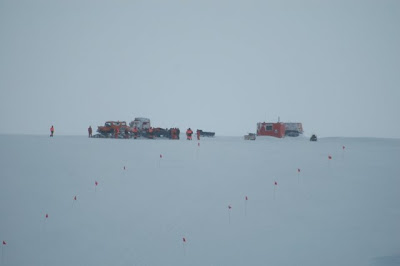Tomorrow we catch the plane back to the UK. I can't wait to see Marion, Margot and Anael! Last night I dreamt I was coming back home, and could not believe how Anael had changed while I was away! I guess in two days it will be like in my dream...
Back to the cruise narrative catch-up. After recovering the moorings, we headed to Creek 3 where we had to supply some equipment for the Halley base and take the Halley VI (the next version of the base) builders onboard.
When we arrived, the Shackleton was already there:

It was good to see it again, and I wanted to go onboard to say hello to the captain and crew. There were also 2 shuttles being arranged to visit Halley. Since I had already been there last year, I let people that had never gone there catch the first shuttle. While we were waiting for them to come back, I kept working, thinking I would have ample time to walk on the ice shelf and visit the Shackleton later. But in the meantime the wind picked up, and since the area was clear of sea ice for miles, waves built up and it was becoming dangerous to stay near the ice ledge. So, as soon as the people that went to visit Halley had come back, the ship left the ice shelf and we waited some distance offshore for the wind to drop... We waited for two days. Finally, the weather improved:

and by the end of March 1st, the wind had dropped suffciently to allow us to quickly come along the ice egde again to take the Halley builders onboard. To make operations wafer, the Shackleton was pushing the ice to prevent an eventual break-up of the ice ledge:

while we were taking people onboard:

and offloading equipment...

for Halley:

The next day, it was our turn to push the ice...

for the Shackleton to offload its cargo for Halley:

Then both ships said goobye to the winterers:

While we were still sheltered from swell by sea ice, Dr. John and I analysed salinity from the water samples with a salinometer:

On the way back North, we met penguins dancing on the ice:

and seals laughing at us:

Finnaly, the last iceberg before leaving sea ice behind:

When we came out of the sea ice area, I felt a bit nostalgic. Was I seeing Antarctica for the last time? I have some ideas of research projects to carry on in Antarctica, but will I ever get the opportunity to write and submit them to funding agencies, and the chance to get one funded?...
We finally arrived in Montevideo, and Julian, Alex, Matt, Pete and I celebrated the end of the cruise with a gin Tonic:

To finish, I'll share my first experience of the green flash, which I had come to believe was a myth!...

The end!



















.jpg)












